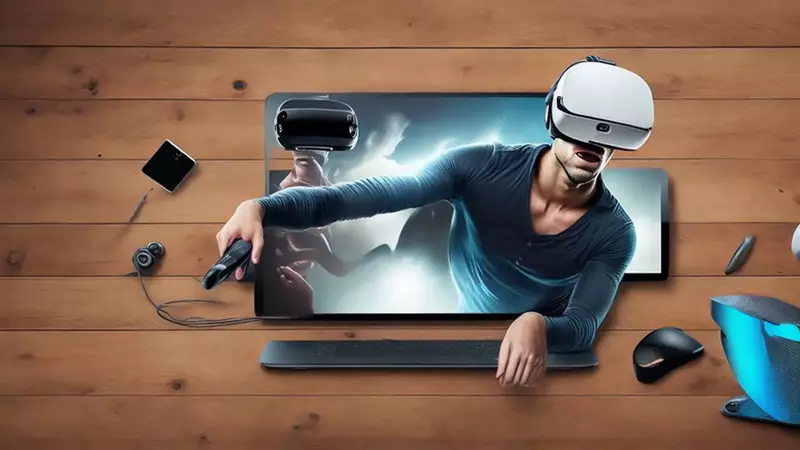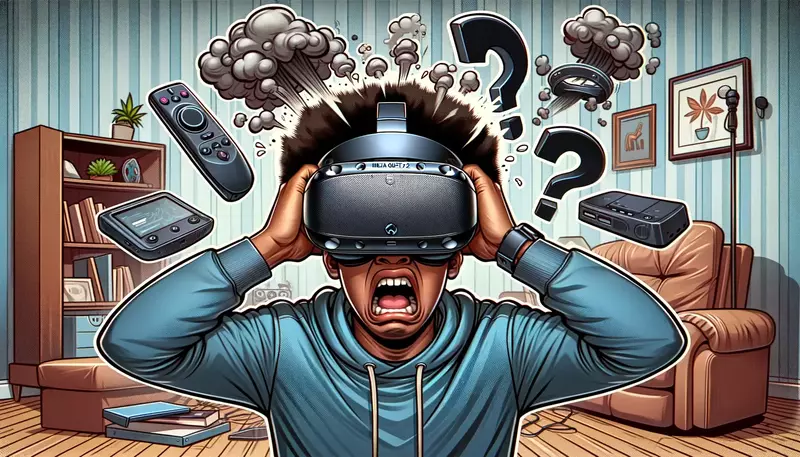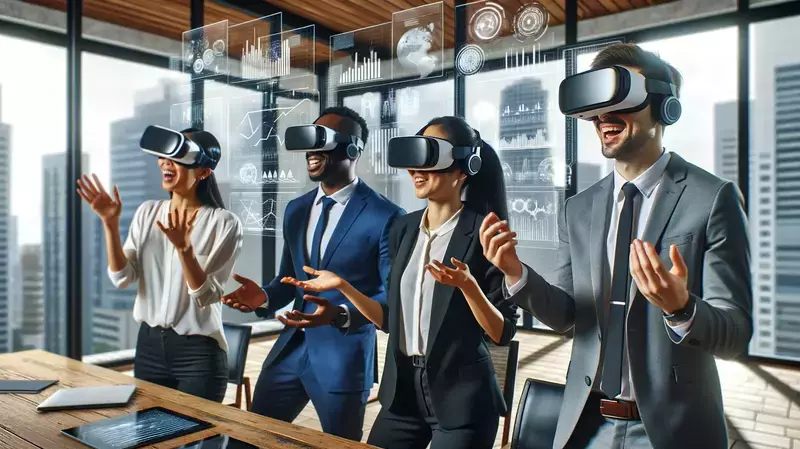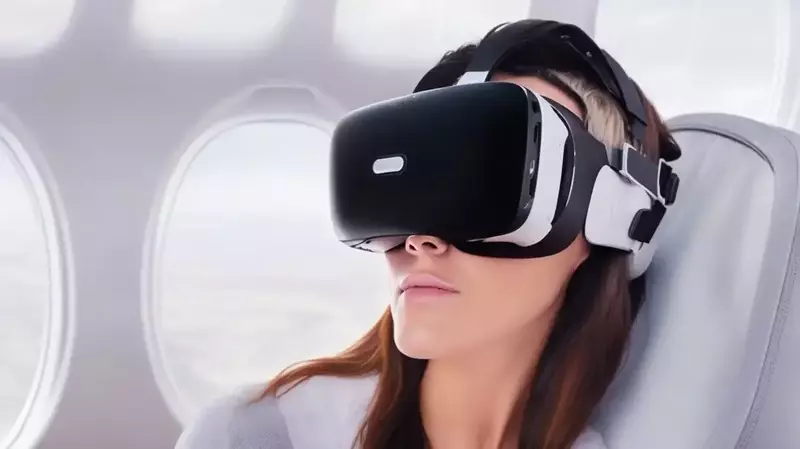This site contains affiliate links to products, and we may receive a commission for purchases made through these links.
Exploring the mechanics behind virtual reality (VR) videos, this blog post will investigate what constitutes such an immersive experience and how it differs from traditional media, as well as look into the process of recording VR content.

Key Takeaways:
- Virtual reality (VR) videos provide an immersive experience by allowing viewers to experience a simulated environment in a 360-degree panoramic view.
- The popularity of VR videos has increased due to the availability of affordable VR headsets, advanced graphics processing units, and high-resolution displays.
- VR content includes 360-degree videos, interactive experiences, and gaming, and it is being adopted by social media platforms and streaming services.
- VR videos have educational and training applications, such as medical simulations and employee training programs.
- VR videos require specialized equipment and techniques for recording, including various types of cameras and spatial audio technology. Viewers can watch VR videos on smartphones, tablets, computers, or VR headsets. The benefits of watching VR videos include exploration, cultural learning, enhanced storytelling, educational applications, and therapeutic benefits.
What is Virtual Reality Video?
Virtual reality (VR) video is a type of immersive media that allows viewers to experience a simulated environment in a 360-degree panoramic view.
This new technology transports viewers to an alternate reality, providing them the ability to traverse distant places and gain novel perspectives from their own abode.
A Brief History of VR Videos
The concept of virtual reality has been around for decades, with early experiments dating back to the 1960s. However, it wasn’t until recent years that VR videos have become more accessible and popular among mainstream audiences.
The advent of affordable virtual reality headsets, advanced graphics processing units (GPUs), and high-resolution displays have contributed significantly to this growth.
Different Types of VR Content
- 360-Degree Videos: These are pre-recorded videos captured using specialized cameras that provide a full 360-degree field-of-view, allowing viewers to look around as if they were physically present at the location where the video was filmed.
- Interactive Experiences: In these types of experiences, users can interact with objects or characters within the virtual environment through various input devices such as controllers or hand gestures.
- Gaming: One major application area for virtual reality is gaming – players can immerse themselves in fantastical worlds and engage in interactive gameplay like never before.
Mainstream Adoption: Social Media Platforms & Streaming Services
Recent years have seen major social media platforms, like Oculus, owned by Meta, start to accept and provide support for 360-degree content on their sites.
Streaming services such as YouTube and Netflix have also started offering VR content, making it easier for users to access and enjoy immersive experiences.
Educational & Training Applications
Beyond entertainment, virtual reality videos are being increasingly used in various educational and training contexts. For example, medical professionals can use VR simulations to practice surgical procedures or explore the human body in detail.
Similarly, companies can utilize VR technology for employee training programs that simulate real-world scenarios without any risk or expense associated with physical locations.
How Do Virtual Reality Videos Work?
Virtual reality videos require specialized equipment and software to capture and create immersive experiences.
This section will discuss the process of recording VR videos, the different types of cameras used, and the importance of spatial audio.
Recording VR Videos
VR cameras come in various shapes and sizes, each designed to capture different aspects of the environment.
Spherical cameras use multiple lenses arranged in a spherical configuration to simultaneously record images from all angles. Rigged systems consist of several individual cameras mounted on a frame that captures images from different angles.
All-in-one solutions combine both camera hardware and stitching capabilities into one device, simplifying the process for content creators who want an easy-to-use solution for capturing high-quality VR video.
Capturing Stereoscopic 3D Video
To create an even more immersive experience, many virtual reality videos are captured in stereoscopic 3D format.
This involves using two separate camera lenses positioned at roughly eye distance apart so that each lens records slightly different perspectives.
When viewed through a compatible headset or display system, these dual perspectives merge into one image providing viewers with depth perception similar to what they would experience in real life.
Post-Production and Stitching
Once the footage has been captured, it needs to be processed and stitched together using specialized software like Adobe Premiere Pro or Kolor Autopano Video.
This process involves aligning the images from each camera lens, correcting any distortion caused by wide-angle lenses, and blending the edges of each image seamlessly to create a smooth 360-degree panorama.
Post-production tasks such as color adjustment may be done to refine the end result.
The Importance of Spatial Audio
Beyond visuals, capturing high-quality spatial audio is crucial for creating an immersive virtual reality experience. Spatial audio refers to the sound that appears to come from specific locations within a three-dimensional space rather than just left or right channels in traditional stereo recordings.
Content creators use specialized microphones such as ambisonic mics or multiple individual microphones positioned strategically around their recording setup to achieve this effect.
Virtual reality videos are considered immersive due to their ability to simulate environments and provide users with a sense of presence in a virtual world.
VR technology has come a long way, and there are now various VR systems and VR content available, such as PlayStation VR, Samsung Gear VR, and HTC Vive. These systems use head-mounted displays and VR controllers to track user movements and provide a realistic experience.
However, it’s worth noting that some users may experience motion sickness due to the simulated environment and head tracking, so taking breaks and adjusting settings is essential to avoid discomfort.
What Technology is Used for VR Videos?
Virtual reality videos utilize a combination of advanced technologies to create an immersive and interactive experience for viewers.
By combining stereoscopic 3D with other technologies, VR videos provide users with a realistic sense of presence within the virtual environment.
Stereoscopic 3D
Stereoscopic 3D technology plays a crucial role in creating depth perception within VR videos.
This technique involves capturing or rendering two slightly different images – one for each eye – which creates the illusion of three-dimensional space when viewed simultaneously through a VR headset.
Head Tracking
In order to maintain immersion and accurately represent the user’s perspective within the virtual world, head tracking technology is employed.
Head tracking systems enable the viewer to virtually traverse their environment by measuring and responding to changes in the position and orientation of their head.
Gyroscope Sensors
- Gyroscopes measure angular velocity (rotation) along three axes: pitch (tilting up/down), yaw (turning left/right), and roll (leaning side-to-side).
- This data is used by software algorithms that translate these movements into corresponding changes in viewpoint within the virtual environment.
- The result is seamless motion tracking that enables intuitive exploration of 360-degree video content.
Magnetometer Sensors & Accelerometers
- Magnetometers detect magnetic fields such as Earth’s magnetic field while accelerometers measure linear acceleration.
- These two sensors collaborate to give more exact details regarding the user’s head position and orientation, thus augmenting the precision of tracking systems for heads.
Positional Audio
Positional audio, also known as spatial or 3D audio, is an essential component of VR videos that contributes to a more immersive experience.
This technology uses advanced algorithms to simulate how sound waves interact with objects in the environment and reach our ears from different directions.
As a result, users can perceive sounds as if they are coming from specific locations within the virtual space – whether it be above, below, behind or beside them – adding another layer of realism to their experience.
How Do I Watch Virtual Reality Videos?
Viewing virtual reality videos is an electrifying, engaging experience that can take you to unexplored realms, societies, and outlooks. To get started with watching VR videos, you’ll need a compatible device such as a smartphone, tablet, computer, or virtual reality headset.
This section will explore the different ways to access VR content on various devices.
Watching VR Videos on a Smartphone or Tablet
One of the most accessible ways to watch virtual reality videos is through your smartphone or tablet. Many popular platforms like YouTube and Facebook offer 360-degree video support directly within their apps. To watch these videos:
- Open the app on your device (e.g., YouTube for Android, YouTube for iOS).
- Search for “360” or “VR” in the search bar to find compatible content.
- Select a video and move your device around to explore the 360-degree environment.
Watching VR Videos on a Computer Browser
If you prefer using a computer browser instead of mobile devices, many websites host VR content that can be viewed without additional software installation:
- YouTube’s official 360 Video channel
- Facebook’s 360 Videos page
- Littlstar, a dedicated VR content platform
Watching VR Videos on a Virtual Reality Headset
For the most immersive experience, consider investing in a virtual reality headset such as the Oculus Rift, HTC Vive, or PlayStation VR. These headsets provide high-quality visuals and audio to immerse you in the virtual world fully:
- Set up your VR headset according to its manufacturer’s instructions.
- Download and install any required software (e.g., Oculus app for Oculus Rift, SteamVR for HTC Vive).
- Browse available content on platforms like SteamVR or Oculus Store.
- Select a video and enjoy an unparalleled level of immersion.
No matter which device you choose to watch virtual reality videos on, remember that this technology is constantly evolving, with new advancements being made regularly. Keep exploring different platforms and devices to stay updated with the latest innovations in VR experiences.
What Are the Benefits of Watching VR Videos?
Watching virtual reality videos offers a unique and immersive experience that goes beyond traditional media consumption. This innovative technology has numerous benefits, ranging from entertainment to education and personal growth.
Exploration and Adventure
By immersing users in realistic environments, virtual reality enables adventurers to traverse faraway lands and experience the world without ever leaving their homes.
Viewers can experience a fully immersive environment with 360-degree panoramas, giving them the sensation of being in the showcased locale.
Learning about Different Cultures
VR videos offer a unique opportunity for individuals to learn about different cultures.
Immersing oneself in VR videos can provide a valuable opportunity to gain knowledge of various cultures, customs, and lifestyles, thus promoting empathy and understanding among different groups.
Educational Applications
Educators have recognized the potential of virtual reality as a powerful teaching tool across various subjects such as history, science, art, language learning, and more.
For example, students can visit historical sites virtually, observe complex scientific processes up close, or even practice speaking foreign languages with native speakers within realistic environments.
Enhanced Storytelling Experiences
VR videos provide a unique platform for storytelling, allowing creators to engage their audience in new and exciting ways.
By placing viewers directly into the narrative, they can experience stories from various perspectives, making them more emotionally invested in the content.
Therapeutic Benefits
VR has been applied therapeutically to help those struggling with psychological issues such as anxiety, depression, and PTSD by allowing them to confront their fears in a safe virtual setting.
Through guided experiences like meditation sessions or exposure therapy, patients can confront their fears and develop coping strategies within safe virtual environments.
In summary, watching VR videos offers numerous benefits that cater to different interests and needs. From exploration and cultural learning to education and personal growth opportunities – there’s something for everyone when it comes to virtual reality experiences.
FAQs in Relation to How Do Virtual Reality Videos Work?
How do virtual reality videos work?
Virtual reality (VR) videos work by using specialized cameras to capture 360-degree footage, which is then stitched together and processed. When viewed through a VR headset or compatible device, the video creates an immersive experience that allows users to explore the environment as if they were physically present.
How does virtual reality work step by step?
- Capture: Specialized cameras record 360-degree footage of a scene.
- Stitching: The individual recordings are combined into one seamless video.
- Processing: The video is formatted for compatibility with VR devices.
- Viewing: Users wear a VR headset or use a compatible device to watch the video and explore the environment interactively.
What is Virtual Reality Video?
A virtual reality (VR) video is an immersive multimedia experience that transports viewers into realistic digital environments. By capturing scenes in 360 degrees, these videos provide users with interactive experiences where they can look around and feel like they’re part of the action. These types of videos have gained popularity in the gaming, education, tourism, and entertainment industries due to their ability to create engaging experiences for audiences worldwide.
How is VR Videos Recorded?
Filmmakers use specialized camera rigs to record VR videos with multiple lenses facing different directions. These cameras simultaneously capture images from every angle required to create a complete panoramic view of the filmed scene. Once recorded, software stitches these separate images together into one continuous image sequence without any visible seams between them, creating an uninterrupted visual experience when viewed on appropriate devices such as headsets or smartphones capable of displaying spherical content correctly.
What Technology is Used for VR Videos?
VR videos rely on a combination of hardware and software technologies. Some essential components include 360-degree cameras, image stitching software, and VR headsets or compatible devices for viewing the content. Additionally, spatial audio technology often enhances the immersive experience by providing realistic soundscapes that match the visual environment.
How Do I Watch Virtual Reality Videos?
To watch virtual reality videos, you’ll need a compatible device such as a VR headset (e.g., Oculus Rift or HTC Vive), a smartphone with Google Cardboard or Daydream View support, or even some desktop browsers like Chrome and Firefox. Once equipped with an appropriate device, you can access VR video content through platforms like YouTube VR, Facebook 360 Video Library, and SteamVR Video Player app, among others.
What Are the Benefits of Watching VR Videos?
- An immersive experience that makes viewers feel present in the scene
- A unique perspective on events and locations not easily accessible in real life
- Potential applications in education for enhanced learning experiences
- Innovative storytelling techniques that engage audiences more deeply than traditional media formats
!! For more information about the different VR headsets on the market, check out this product specification list.
Final Thoughts
In summary, virtual reality videos offer a captivating experience that enables users to sense they are part of the situation. These videos are recorded using specialized cameras and technology that capture 360-degree views. To watch VR videos, you need a compatible headset or device.
Watching VR videos can provide numerous benefits, such as increased engagement, enhanced learning experiences, and improved entertainment value. If you’re interested in exploring more about how virtual reality videos work, visit Pursuit Meta for all your VR needs!

Espen
Espen is the Director of PursuitMeta and has written extensively about Virtual Reality and VR Headsets for years. He is a consumer product expert and has personally tested VR Headsets for the last decade.




Leave a Reply